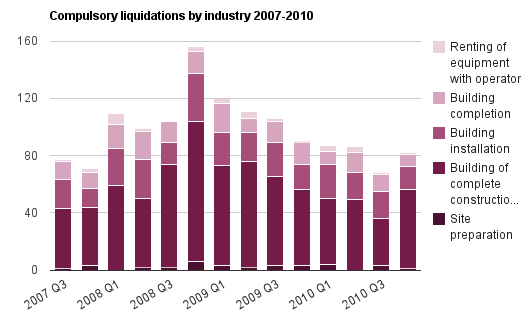The downturn has put many contractors out of business, says Brian Moone. What impact is this likely to have on project lead times?
Despite construction starts falling to the lowest level for years, there may have been some comfort in the reports at the end of last year that the number of companies going into administration slowed down in the third quarter of 2010 and was lower than 2009.
However, many clients and main contractors are becoming concerned about the increased risk of companies going out of business during the recovery from the recession. Many companies will become stretched as the cost of labour and materials increases and businesses struggle to cope with the lag in cash flow. If other firms need to step in and take over contracts, what will the effect on lead times be?
First response
Whether the company affected is a main contractor with subcontractors or a client with main or trade contractors working directly for it, the first action is to mitigate against risk. Many main contractors and clients are increasingly using financial risk monitoring services in an attempt to ensure that they avoid a difficult situation.
The next action is to monitor the risk during the project, for example, by placing key suppliers on daily financial monitoring to ensure they are alerted as soon as any risk arises. This enables them to consider the alternative strategies early to ensure minimum impact on the programme. These services have a value but are limited in trying to forecast future events based largely on historic data, so there is a risk that companies will slip through the net and fail, leaving their clients to pick up the pieces on the project.
Trade packages carry different risks. Any packages with a high percentage of material or plant with long lead times are the highest risk, while high labour content activities such as decorating will be easier to recover.
Typically, the long lead items include the mechanical and electrical packages with large plant items. In the event of the company ceasing trading, the client or contractor will need to identify who owns these items and whether they can be transferred to the client or the contractor. Accommodating the change will require the planners to rearrange the programme where possible to place the activities outside the critical path.
Review of the key lead time elements
It is important to review the key elements that make up lead times. The lead times published on the previous spread analyse: production and approval of drawings; procurement of materials; manufacturing; and approval of samples.
Below are some of the factors to consider in each of these areas:
- Period for production of working drawings by contractor
If the new contractor needs to take on the design risk it will be necessary to review existing designs and to redesign any incomplete work. The combination of the two can increase the lead time.
- Period for approval by design consultants
Apart from the abortive element of the programme and the duplication, the lead time for approval process by design consultants should not be unduly affected.
- Procuring materials period
Where standard materials and components are used, standard lead times can be applied. If the materials are on long lead times, the contractor may have to resolve the ownership issues before being able to take over the order, in which case the lead time will be affected by the change in contractor.
- Manufacture period
Any preassembled items specific to the project may be delayed. Ownership issues will need to be resolved, particularly where the items have already been manufactured or purchased for the project. Any new or partial production will need to be remobilised and potentially wait for new production slots in the factory, increasing the lead times.
- Provide/agree samples
There will be little impact on the time taken to agree samples. If these have already been agreed, and the samples kept, the process may not need to be repeated.
- Mobilisation/site establishment
The new contractor will have to remobilise on the site and the mobilisation may become extended due to the need to take over the existing works, particularly as they may have to occur out of sequence and access and egress may become hampered.
While every effort may be made to mitigate against the risk of contractors going out of business during a project, as recent high profile companies like Connaught and Rok have shown, it is not entirely possible to avoid. Where it does occur, the impact on the client and main contractors can be significant. In the current downturn it is advised that clients and main contractors consider identifying their higher risk suppliers and contractors and ensure they have strategies in place to address the implications of these companies going out of business.

























No comments yet